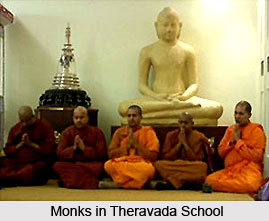 In accord to the doctrine of Theravada Buddhism, the insight in an individual must evolve from his experiences, understanding and reasoning instead of blind faith. The doctrine widely promoted the concept of "Teaching of Analysis." The Theravada scriptures however say that a wise man is indeed required to guide an individual. As a result apart from an individual`s own experience he should also rely on the advice and the judgment of the wise man or elders.
In accord to the doctrine of Theravada Buddhism, the insight in an individual must evolve from his experiences, understanding and reasoning instead of blind faith. The doctrine widely promoted the concept of "Teaching of Analysis." The Theravada scriptures however say that a wise man is indeed required to guide an individual. As a result apart from an individual`s own experience he should also rely on the advice and the judgment of the wise man or elders.
The philosophy of Theravada Buddhism propagates that the primary cause of human suffering lies in his desires. These desires or cravings include greed, anger, jealousy, fear, passion, hatred, vengeance, pride, cardinal pleasures, aversion and others. The levels of these defilements were divided into coarse, medium, and subtle. These defilements are temporary phases, which harms the individual as well as the people surrounding him. It is also the main reason behind all the inhumanities that man commits. The only way to escape from dukkha is by following the principles of Buddhism.
The doctrine of Theravada believes that these cravings or dukkha arise in man out of ignorance or avijja. Out of ignorance men consider these defilements apart of their self. Actually they are nothing but parasites that affect the mind and create pain and suffering. These ignorant human beings consider their bodies as their possession whereas the truth is that the body is made up of four elements i.e. Earth, Fire, Water and Air. After death the body decomposes and returns back to its original forms. But the defilements manipulate and instigate the mind and prevent it from seeing the obvious.
In order to free oneself from the cycle of pain and suffering it is essential for the individuals to get rid of these vices. The only way to eradicate them is through logic, analyzing and experience. To understand the true nature of the vices one needs to practice jhana. This practice will lead the aspirant to the Four Noble Truths, Enlightenment and ultimately to Nirvana. The ultimate aim of Theravada Buddhism is Nirvana. This is the stage that liberates a man from the cycle of birth, death and rebirth and helps him to attain spirituality.
Theravadins strongly believe that each individual is responsible for his karma (action and decision) and in the process he is the sole one responsible for his liberation too. To achieve nirvana the only way is to follow Noble Eight fold Paths. This discipline believes that gods are incapable of granting human beings from their sufferings as gods themselves incorporate the defilements like wrath, vengeance, hatred, delusion and greed. For the followers of Theravada, Buddha was a teacher who showed them the Eight fold Paths.
It is possible to attain Nirvana in one lifetime by an Arhant. The followers of Theravada Buddhism believe that those who attain nirvana are similar to Buddha. However Gautama Buddha was superior to the other arhants because he himself discovered the path to achieve it. Theravada looks up to Buddha as a supreme individual who found a way to nirvana and imparted the knowledge to others. However, this discipline also recognizes the existence of such Buddhas in the distant past or near future.
The remarkable feature about Theravada School of Buddhism is that the followers of this discipline can either blindly follow the teachings of Gautama Buddha or verify them through their experience and analyzing power. Very few religious discourses in the world propagate such principles.



















